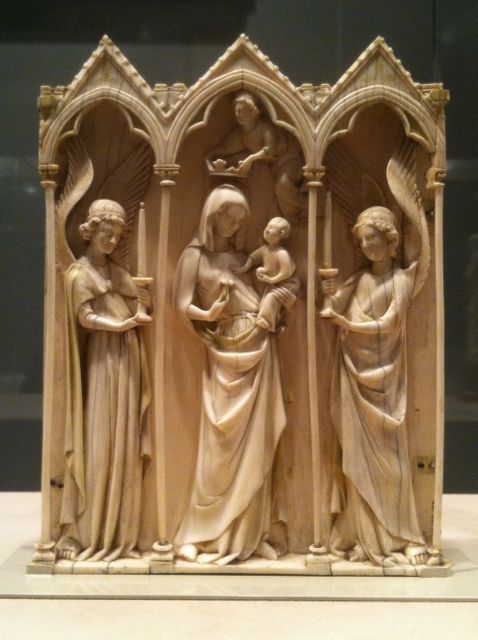
This tryptic of Mary and Jesus with three attending angels is a small ivory piece in the Metropolitan Museum of Art in New York. it is about the size of a salad plate and was carved in the middle ages, probably for the cover of a book or as a traveling devotional piece. In it the folds of cloth and the wings are carved with great precision and the whole piece shows off light and dark so well that we can almost feel the light and dark metaphors of John’s gospel.
The piece is set in in church architecture rather than in a pastoral scene or in a house. The architecture is gothic, like that of the cathedral with carved, pointed arches rooting the image in the earth and yet pointing up to heaven.
What strikes me when I meditate with this image as if using it as an icon (any image can be an icon for meditation) is that at first I see only two angels. It is not until I look closely that I see the third, crowning Mary as queen of heaven. Her right hand is about to open her dress so that Jesus may take nourishment, a symbolic gesture inviting humanity to take spiritual nourishment. Jesus is looking just past her face into God’s and his smile is a smile of joy and even playfulness. In one hand he holds the orb, a symbol of rigging over the cosmos. The other hand is placed very lightly on her chest, over her heart as if to heal that which will be broken when he is.
What if God is as pleased with each one of us as he is with Mary? What if she is not as singled out as we think? what if there are angels holding the torch-light for us – each one of us – unseen by our human eyes? I think we humans like having royalty around us. We like to worship the rich, the powerful and the pretty. We like british royalty and we make sports stars and film stars into a kind of royalty.
It has long-served the latin church to set up layers of prestige. It is essential to hierarchy to have different classes of prestige. Priests are raped in brocade, Bishops wear massive rings and crown-like hats, hairs have different heights. Processions are all a muddle at first as people jockey for position – where do I fit? How important am I? Can they see me? Church tends to be a pretend land of excruciating precision perhaps because life is so not that way. Life is so messy that we deal with our anxiety about the messy by making church precise, pretty, perfect. And I love beauty so I love how we do church. But this icon reminds me that while we do pretty and love hierarchy (especially clergy!) we also follow a savior whose life never really looked like this and yet we love to make his life to look like this in art and in church. We want the confines of the arches and columns because the messy wilderness freaks us out. We want the extending angels with candles because the darkness freaks us out. We want the crown on Mary because her simplicity and humility freaks us out.
IN art, we know that the exposed foot of Jesus is a symbol of his vulnerability. Can you see that the out-turned foot of Jesus is the absolute center of this piece of art? Those little, vulnerable toes are pointing straight out into the viewer. That little foot, the locus of most of our nerve-endings and so the place on our body where we feel both the most pain and the most pleasure when they are massaged by a trusted loved one – our foot is vulnerable. That is why shoes were the most important thing for concentration camp victims in Germany and why dogs flinch automatically when you touch their paw.
What if God simply wants us to know we are loved while we run around setting up systems of power and symbols of authority? What if God wants us to look away from the mangers which are clean and white, and look at the manger with the cow dung on the floor. What if we are being invited to look down from Mary’s crown to the blood on the straw between her legs. What if we are invited to be real?
The trick to life is to do the four things Jesus is doing in this image. Expose our feet to pain and pleasure. Keep one hand on love. Look into God’s eyes. And lighten up.

